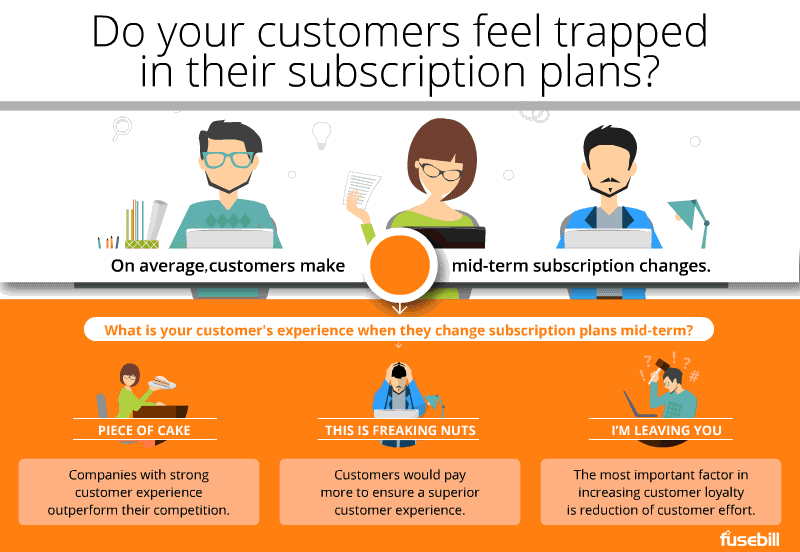In 2018, optimistic forecasts were that SaaS revenue would hit the $100 billion point the following year; when, in fact, that number was reached by the third quarter of 2018. Then, nearing the end of 2019, that number swelled to $141 billion.
RELATED: 6 Best Practices for Subscription SaaS Billing
Once more, 2020 promised to be a banner year for SaaS businesses as popularity showed no signs of slowing down. And of course, the COVID-19 pandemic thrust some SaaS solutions into the spotlight even more as professionals and students were forced to start working and learning remotely.
However, great success yields even greater competition, and if the SaaS market was saturated before, it’s growing positively soggy by the day. But that doesn’t mean there isn’t room for incredible scale and success amidst the mass.
Success isn’t finite, and if customers are responding to what you’re offering, you’ve got growth potential. The thing to keep top of mind is those customers.
No matter your industry or your niche, if you don’t have happy, satisfied customers, you probably won’t have customers at all. So how do you set yourself apart from other SaaS businesses and rise to the top in a highly competitive environment?
Seamless customer service leads to great customer success.
Digital Transformation and Your SaaS Subscription Billing Software
SaaS businesses are in a unique position when it comes to customer service success. Unlike the traditional sales model that views the seller-buyer relationship as a largely one-time transaction, businesses that use the subscription model have to keep their customers happy on a continual basis.
While it may sound a bit overwhelming, your company doesn’t need to be a solo act when it comes to managing all the moving parts. By actioning effective digital transformation solutions—or building out your technology stack to address your business challenges—you can provide a superior customer experience.
You’ll also likely add efficiency, agility, and scalability, which will accelerate your growth.
While SaaS billing and collections are rarely the first things businesses think of when they’re looking for ways to digitally transform and optimize their customer experience, it’s a crucial element.
Why? Because it’s a regular part of your customers’ ongoing experience with your subscription-based business. In fact, your recurring invoices are a constant customer touchpoint. It’s incumbent on your business to do this right.
Let’s take a look at five different ways your business’s SaaS customer experience may be slipping, and how you can turn it around by adding an agile subscription management and subscription billing software to your technology stack.
1. How Easy is it to Get Onboard Your SaaS?
Starting at the very outset, think about your initial subscription process. How user-friendly is it… or is that something you know you need to address ‘eventually’?
You may have the best product out there, and it might be priced competitively. But if customers struggle with subscribing and getting started, they may very well decide to abandon the process before it has really even begun.
Consider The Covenant Group—an organization with two and a half decades of proven excellence in coaching professionals in some of the world’s largest business institutions. When The Covenant Group began updating and building out its technology stack, it knew its subscription management would need to evolve in the process.
When new clients used to start with the organization, they would have to go through a lengthy manual process of receiving a faxed invoice, receiving reminders by fax, sending their payment details by fax, and then working with the organization to set up their account before their professional training could ever begin.
Since implementing its agile recurring billing software, The Covenant Group now empowers its clients with a self-service portal. They can quickly and easily choose their coaching journey, add their own account and payment details, make payment, and immediately get started.
This kind of streamlined, automated customer experience reduces friction for clients, nixing the potential for account errors and eliminating inconvenient and potentially time-consuming customer service interactions. The transformation also saves time for The Covenant Group team members to focus on higher level objectives.
There are different ways to evaluate your own customer sign-up and onboarding process. One way is to review your levels of cart or sales process abandonment. Are people preparing to purchase your product, only to give up before it comes time to buy? If so, it’s critical to give your process a good look.
Another way to determine issues is to measure how many calls are going to your customer service department before and immediately after sign up. Is your team continually being contacted by potential new customers? At what point in the process are people struggling and what are they struggling with?
Your customers should be able to negotiate the sign-up and onboarding journey with ease.
An adaptive subscription management and automated billing system simplifies the subscription process by taking it from a manual mission to a smooth, automated experience.
2. Can Your Customers Make Subscription Changes Themselves?
According to Hubspot, less than half of all customers prefer to place a phone call to reach customer service. This means if you don’t provide good alternatives, you could be irritating over 50% of your customers.

One alternative that’s increasing in popularity is self-service portals or SSPs. These ease customers through their experience with your company by putting them in the driver’s seat when it comes to making account changes.
The SSP can also be accessed at any time, so customers can take actions as and when needed, including:
- updating their contact data
- updating payment information
- accessing purchase history and invoices, and even
- performing subscription plan migrations, whether upgrading or downgrading subscriptions.
Transforming your customers’ experience in this way saves everyone time and ensures customers’ have exactly what they need from your business precisely when they need it. No more waiting for your team to respond.
Adding a modern subscription management and billing system to your technology stack allows you to implement state-of-the-art SSP functionality, providing flexibility that best matches your unique business needs. For example, you may want to allow customers to use the SSP to upgrade subscriptions but require them to contact you if they want to downgrade.
And even if you choose not to provide SSP migration functionality to your customers at all, agile recurring billing solutions make the plan migration process seamless anyway.
Regardless, when your business undergoes this digital transformation, you eliminate the frustration that comes when customers are forced to reach out and spend precious time making changes and updates. Keeping the process smooth throughout the customer lifecycle is essential when establishing your business as an industry leader.
3. Does Your Finance Team Have to Chase Down Unpaid Invoices?
Phone calls for unpaid invoices are never going to be a welcome communication for your customers. Wouldn’t it be simpler to have an automated system that works behind the scenes to make sure invoices get paid in the first place?
Subscription billing software easily addresses this issue by automatically sending customers scheduled email reminders about upcoming card expiries, payment due date, and even late or overdue payments—in addition to other important information you’d like to convey. Your customers are busy. This enables them to take the actions they need to on their own terms.
When payments do fail though, it happens for many different reasons. An adaptive billing platform will also perform automatic card retries on a pre-determined schedule—often beginning before either you or your customer are even aware there’s a problem. Card retries can dramatically reduce effort on both sides, as well as involuntary churn from failed and unaddressed payments.
Automatic retries are ideal during times of economic downturns. The more a customer needs to consciously think about providing an alternative payment method, the more likely they are to consider the pros and cons of staying with your business.
4. At Tax Time, is Your Customer Service Team Swamped with Requests for Invoices?
This may seem like a small thing, but when people are stressed at tax time, the less documentation they have to chase, the better.
If a customer has, for example, five business-related subscriptions they pay for monthly, that’s 60 invoices they need to compile. This would be overwhelming for anybody.
The SSP offered through complete subscription billing software can address this pain point, though. If customers can tap into a SSP through a sophisticated billing system to generate copies of invoices, they’ll appreciate that shortcut.
5. Are Your Customers Refuting Invoices?
If you have a manual billing system, the chances of mistakes being made are high because, of course, humans make mistakes.
Perhaps a customer migrated to a new plan but the change isn’t being properly reflected in their billing. Or a team member may forget to turn off a discount for several months, so affected customers get used to the reduced rate.
Not only does this set up the opportunity for billing disputes in the future when the true subscription fee is re-instated, but also think of all the revenue that was inadvertently lost while the discount was still active.
Even simple typographical mistakes can generate inaccuracies that affect the SaaS customer experience. However, with the right software in place, invoices are accurate every time.
With an agile recurring billing system, invoices are automatically generated each period from customers’ account data, rather than having to be continually recreated. Subscription discounts and coupons are scheduled with specific parameters so you never have to remember to remove or adjust them, and payment detailed surrounding plan migrations happen automatically.
For example, if a customer upgrades their subscription, the billing system not only makes sure the new price is reflected in future invoices, but it also calculates the difference of the subscription cost for the remaining days in the current subscription cycle.
Conversely, the billing software makes any adjustments if a customer downgrades their subscription, issuing any credits within that billing cycle, while also making sure future invoices reflect the reduced price.
Those changes are fed directly into the invoice, so businesses know that any financial changes are accurate.
Precise, predictable invoices are important in maintaining relationships because inaccuracies will erode your customer’s confidence in your business.
After all, if you can’t get your invoices right, they’ll wonder what else is wrong with your business.
Does Your Subscription Billing Software Deliver a Satisfying SaaS Customer Experience?
When you’re thinking of your customer experience, chances are, you’re not thinking about your billing system—but maybe you should be. It touches many different facets of your business, starting at signup and progressing through the entire customer lifecycle. It can also help to reduce your churn rate—including both voluntary and involuntary churn—so your business can retain and build its most valuable asset: its customers.
With the right solutions in place, you can improve the customer experience from the moment they decide to sign up for your product, through the recurring billing process. Customers are empowered to adjust their service with your business as and when needed, and consistently accurate and accessible invoices establish a professional and trustworthy—and hopefully long-term—relationship.
You Might Also Like: How Does an Enterprise SaaS Company Set Up Complex Recurring Billing?
By eliminating subscription and billing-related issues and smoothing out the communication process, you’re conveying to your customers how much you appreciate their business and underscoring why they started working with you in the first place—instead of the competition.
SaaS customers don’t want to feel like they’re just a number. They want to know that their subscription matters to your business. You know how important it is to keep your customers coming back every month—by delivering a superior SaaS customer experience, you ensure they know it too.
![AdobeStock_286536674 (1) [Converted]](https://staxbill.com/wp-content/uploads/2022/07/Customer-Experience-SaaS-Billing-1024x659.jpeg)






